Starting 1 July 2025, Tenaga Nasional Berhad (TNB) revised its Maximum Demand (MD) charges for medium-voltage non-domestic customers under the Time-of-Use (TOU) scheme to RM97.06/kW. While this might seem like just another tariff change, the reality is more urgent: just one unexpected 30-minute power spike during peak hours (2pm – 10pm) can cost your business thousands of ringgit.
That’s where EasiEMS comes in. Our Smart Peak Demand Control system empowers you with real-time visibility, predictive alerts, and control — all aimed at helping you avoid costly MD penalties.
Why TNB Maximum Demand (MD) Charges Matter
Under TNB’s TOU scheme:
- Peak Hours: 2:00 PM – 10:00 PM (Monday to Friday)
- Off-Peak Hours: 10:00 PM – 2:00 PM (including weekends and holidays)
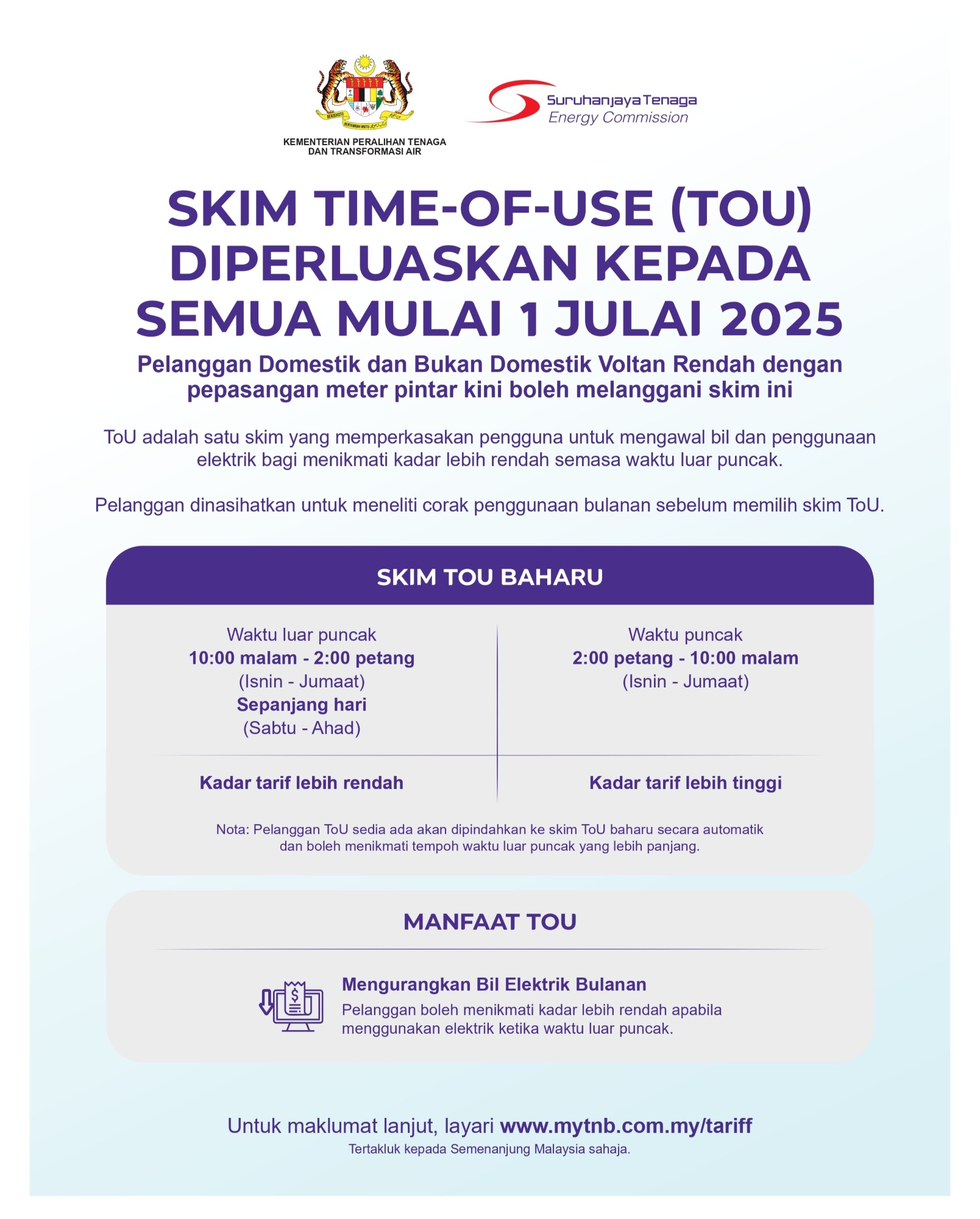
Your MD is calculated based on the highest 30-minute average kW usage during these peak hours. With the new charge of RM97.06/kW (RM30.19 for Capacity + RM66.87 for Network), this adds up quickly — especially for energy-intensive industries.
Even a brief spike in demand can lock you into a higher monthly MD charge, even if your average consumption is low.
Meet EasiEMS – Granular MD detection (Beyond MSB Level)
EasiEMS is designed to provide insight and control at every level:
- Main Switch Board (MSB) Level– Real-time monitoring aligned with TNB’s 30 mins MD calculation
- Child Node Level – Pinpoint which distribution boards cause peak demand
- Machine Level– Identify the exact equipment contributing to MD spikes
EasiEMS + BESS: Next-Level Peak Shaving & Adaptive Demand Control
Why integrate BESS with EasiEMS?
Adding Battery Energy Storage (BESS) turns your demand control from reactive to proactive. Rather than simply limiting loads during a spike, you gain the ability to smooth, shift, and time your energy flows — giving you:
- Battery-Aware Peak Shaving
During TNB peak windows (2 PM – 10 PM), the BESS discharges stored energy to reduce grid demand and shave off the maximum demand (MD) peaks. After the peak window, it recharges during off-peak hours or when solar is abundant, avoiding unnecessary grid draw. - Adaptive Demand Control
Our AI monitors load patterns, forecasts demand surges, and dynamically controls when to shed loads or deploy battery power. Over time, it “learns” your building’s behavior to optimize strategies per unit, zone, or machine. - Guaranteed Savings & Audit-Grade Reporting
With intelligent peak shifting, you can reduce MD charges by 10% to 20%, depending on load profile. All with monthly, exportable reports, and baseline verification. - Zero-CAPEX Option + ROI Share Model
Don’t want to commit capital upfront? We offer a savings-share scheme: Tanand supplies the battery (or co-finances it), implements the system, and you pay only as you save — while we guarantee the returns.
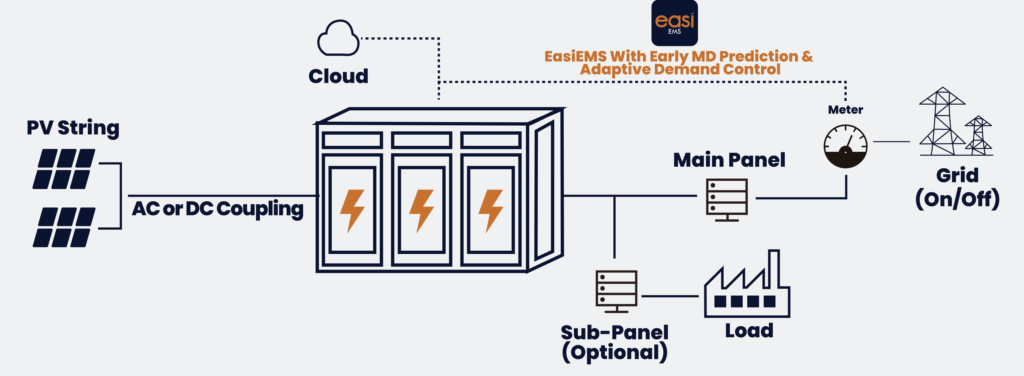
Early Maximum Demand Warning System -
Stop MD Before It Happens
EasiEMS continuously calculates your 30-minute running average demand, just like TNB’s meter.
Example Scenario:
- Target MD Limit: 800 kW
- Current Average at 2:15 PM: 750 kW -> early warning triggered
- Projected 30-Minute Peak: 810 kW (if no action taken)
At this point, EasiEMS triggers an Early Warning via Telegram/WhatsApp, Email, or the Mobile App, with recommendations on what actions to take — before an MD breach happens.
Smart Load-Shedding – Automated Recommendations in Real Time
EasiEMS goes beyond alerts. It recommends exact actions based on equipment type, runtime, and load priority.
| Equipment | Rated Demand (kW) | Suggested Action |
|---|---|---|
| AHU 3 (Office Zone B) | 25 | Switch off for 30 minutes |
| Air Compressor 2 | 45 | Delay operation for 15 minutes |
| Chiller 2 | 90 | Temporarily reduce setpoint/cycle-off |
| Production Line C Fan 5 | 10 | Switch off for 15 minutes |
Automated Demand Limiting Control
For key equipment connected to the Max Demand Limiting Controller, EasiEMS enables:
🖥 Remote Switching – One-click OFF from the dashboard
🤖 Auto-Control Mode – Auto switch-off for 15 or 30-minute intervals on selected loads
This ensures immediate action, even when staff can’t respond fast enough.
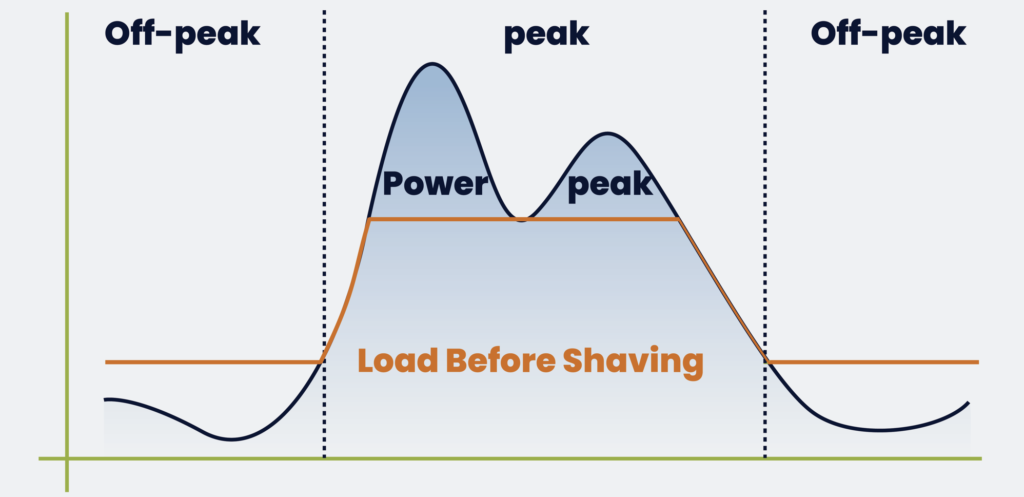
Why Choose Tanand’s BESS-Integrated EasiEMS Pro vs. Hardware-Only Providers?
- Not just batteries, but intelligence— Many suppliers offer hardware with basic peak-shaving logic. Tanand delivers full-stack AI + BESS orchestration, adapting to your operations in real time.
- Proven ROI with zero upfront risk— Through our savings-share model, we take on the implementation risk and guarantee returns.
- Vendor-neutral & modular— Works with standard battery chemistries and BMS/EMS systems — no proprietary lock-in.
- Holistic energy strategy— We help to size your BESS correctly – to prevent over-sizing your batter
High‑Level Benefits
- Lower MD charges without sacrificing comfort/process.
- Short payback (solution‑first) and CAPEX‑free option with shared savings.
- Future‑proof: ready for BESS integration and portfolio scaling.
Implementation Timeline (Typical)
- Week 0–2 → Data onboarding & baseline
- Week 3–4 → Pilot installation
- Week 5 onwards → Auto-control + ongoing M&V
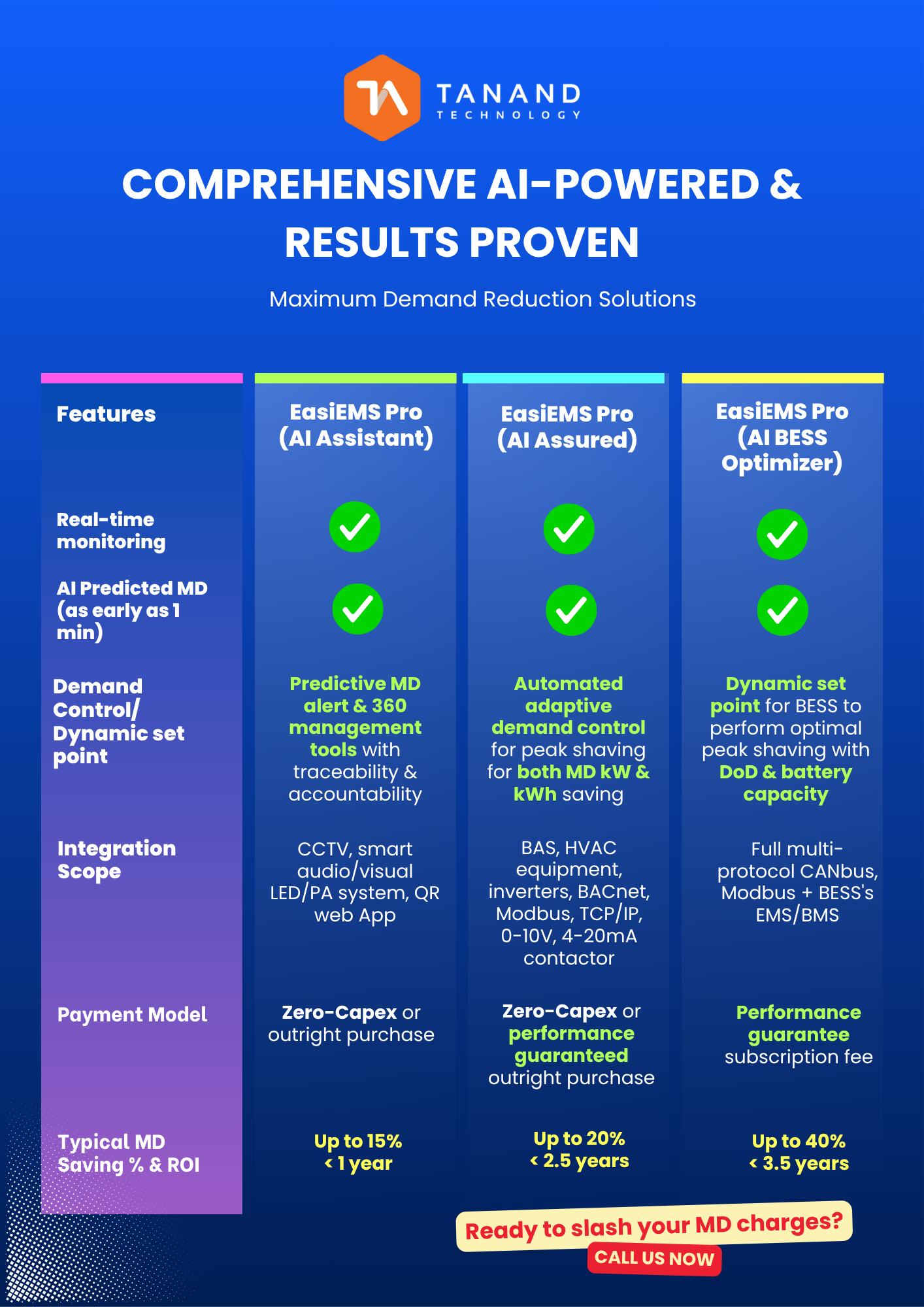
Case Study Simulation – What You Can Save
By strategically reducing MD, you could save tens to hundreds of thousands of ringgit annually:
| MD Reduction (kW) | TOU MD Charge (RM97/kW) |
Monthly Saving (RM) | Annual Saving (RM) |
|---|---|---|---|
| 20 | RM1,940 | RM1,940 | RM23,280 |
| 50 | RM4,850 | RM4,850 | RM58,200 |
| 100 | RM9,700 | RM9,700 | RM116,400 |
| 200 | RM19,400 | RM19,400 | RM232,800 |
Case Study Simulation – Before vs After EasiEMS Implementation
A semiconductor plant previously recorded an MD of 2550 kW during peak hours, resulting in a monthly MD charge of RM82,501 (850 kW × RM97.06). After installing EasiEMS, the plant successfully reduced its peak demand to 2450 kW by automatically cycling off two air compressors and rescheduling non-critical AHUs during the 2 PM to 10 PM TOU window.
This 100 kW reduction translated to a direct monthly saving of RM9,706 and an annual saving of RM116,472. Additionally, by reviewing machine-level MD data, the plant optimized chiller operations, achieving further energy savings beyond the MD cost reduction.
Before vs After EasiEMS – MD Cost Comparison
| Item | Before EasiEMS | After EasiEMS |
|---|---|---|
| Maximum Demand (kW) | 2550 kW | 2450 kW |
| MD Charge Rate (TOU) | RM97.06/kW | RM97.06/kW |
| Monthly MD Charge | 2550 × RM97.06 = RM82,501 | 2450 × RM97.06 = RM77,648 |
| Monthly Saving | – | RM9,706.00 |
| Annual Saving | – | RM116,472.00 |
Based on non-domestic medium voltage with ToU, Max demand charges (during peak hours):
Capacity Charge: RM30.19/kW + Network Charge: RM66.87/kW = RM97.06/kW
ToU scheme has 2 time zones (Peak and Off-Peak):
- Monday to Friday: Peak: 2:00pm to 10:00pm
Off-Peak: 10:00pm to 2:00pm - Saturday, Sunday and Public Holidays*:
Off-Peak all day (24 hours) ← Lower Footer
MD is measured in Kilowatt (kW). MD is the highest level of electricity demand recorded by TNB meter during a 30-minute interval in a month that occurs during peak period.
The kW amount charged to customers is based on Recorded MD (kW) x *MD Charge Rate
| Non-Domestic Medium Voltage ToU Tariff | ||
|---|---|---|
|
Energy Charge For all kWh during the peak period |
sen/kWh | 31.32 |
|
Energy Charge For all kWh during the off-peak period |
sen/kWh | 27.23 |
|
Capacity Charge For each kilowatt of maximum demand per month during the peak period |
RM/kW | 30.19 |
|
Network Charge For each kilowatt of maximum demand per month during the peak period |
RM/kW | 66.87 |
| Retail Charge | RM/month | 200.00 |
EasiEMS Smart Peak Demand Control
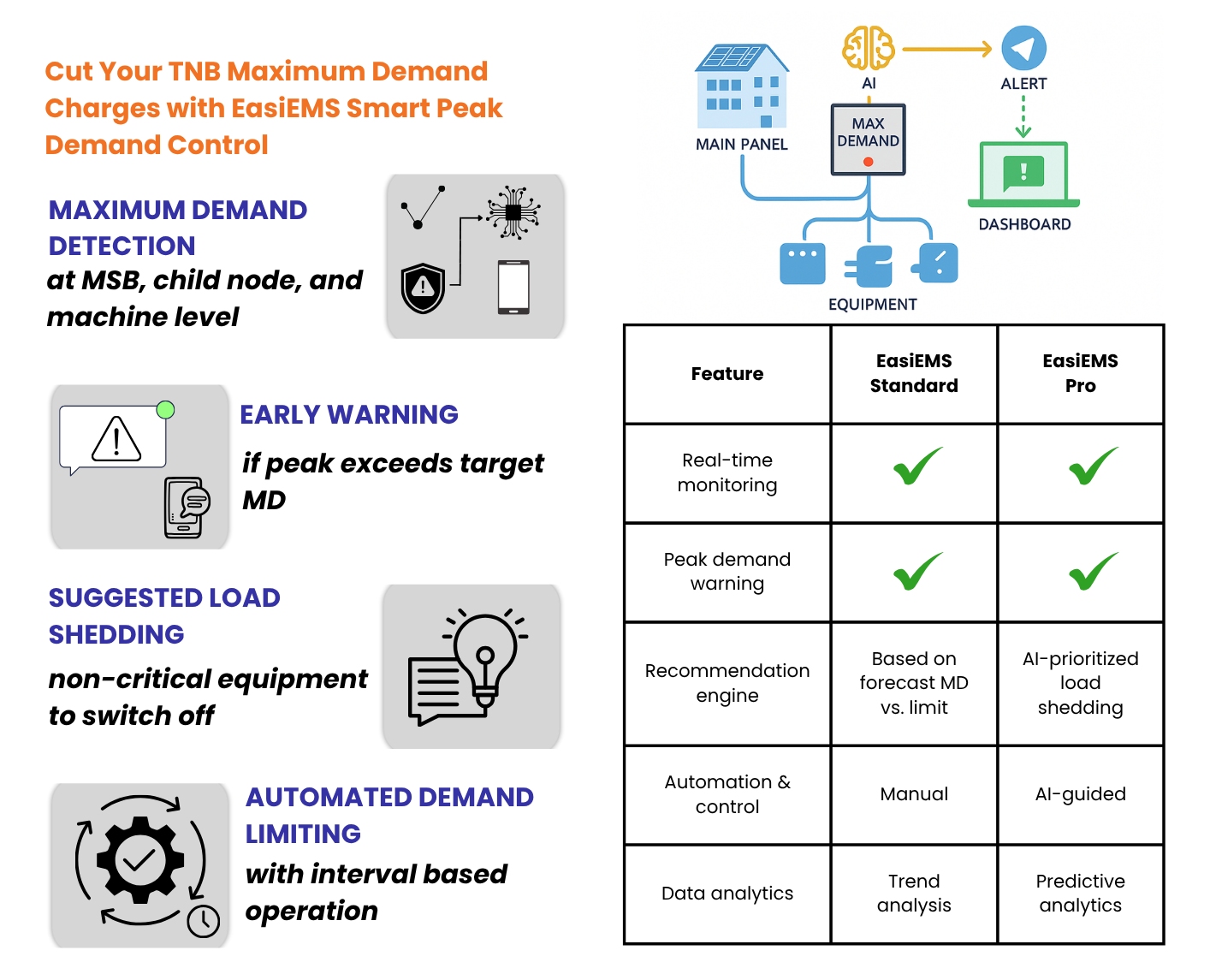
Conclusion - Lower Your Energy Bills Without Sacrificing Operations
When just 30 minutes of high usage can cost you thousands, you need more than manual monitoring. EasiEMS makes energy-saving automatic and stress-free.
With smart alerts, equipment-level insights, and built-in load control, you can reduce Maximum Demand charges while improving overall energy efficiency — without affecting daily operations.
Whether you’re managing a factory, commercial building, or industrial site, EasiEMS gives you the visibility and control to save money every month.
Let us show you how much you could be saving. Reach out to our team to assess your eligibility and project fit at our contact page to speak with our technical experts.


